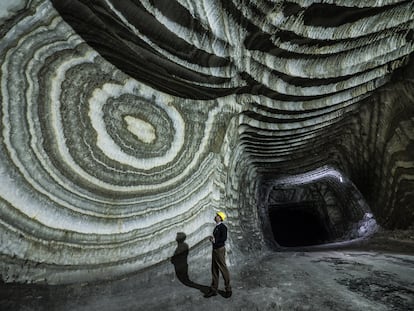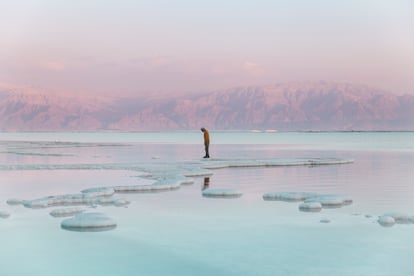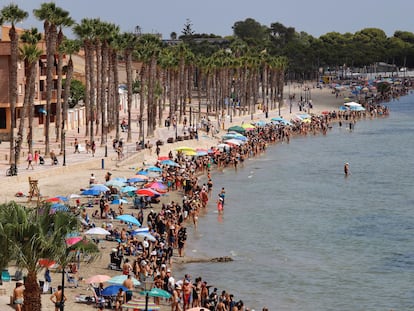Mediterranean marine life nearly disappeared when it became a dead sea
A disconnection with the Atlantic Ocean six million years ago caused a rise in salt concentration, creating a half-mile-thick layer of sodium chloride that caused a regional extinction on a similar scale to that of the dinosaurs

During World War II, German submarines took advantage of a peculiar aspect of ocean physics to pass through the Strait of Gibraltar unnoticed by the British army. The crafts set on entering into the Mediterranean rose to shallow waters, turned off their engines and allowed themselves to be carried by the current. Those who wanted to cross over to the Atlantic descended to deeper waters to be similarly swept out in silence. They were making use of the waters’ density difference. The higher salt concentration of the Mediterranean waters causes objects to sink, while the waters of the Atlantic, less rich in sodium chloride, makes them float higher. This exchange between the sea and ocean, a vital relationship for the Mediterranean, was cut off six million years ago, causing, according to a new study published in Science, the almost total death of its marine life. By the time the passage between the two bodies of water reopened, the biodiversity of the Mare Nostrum had changed forever.
Six million years ago, the Mediterranean had a configuration similar to its modern-day form. It had long since lost its connection to what would become the Indian Ocean and was separated from the Paratethys Sea by the rise of the Anatolian Peninsula. It would have been a closed-off body of water if it were not for the strait that connected it to the current Atlantic. It stayed open thanks to what is now known as the Strait of Gibraltar. If it had been known by a name back then, it would have been the Strait of Cazorla, because the passage opened up through lands now known as the southern Spanish province of Jaén and most of the Baetica region. In general terms, the salt differential between Mediterranean and Atlantic waters is four grams of salt per liter more in the former as compared to the latter (39 grams per liter versus 35 grams per liter). But geological dynamics began to work against fluid dynamics.
Geologist Daniel García-Castellanos from the Spanish National Research Council’s Geosciences Institute of Barcelona (GEO3BCN) explains what took place: “At the end of the Messinian, due to geodynamic processes, this region began to rise, initiating the disconnection between the two sides.” The process didn’t happen all at once—it progressed over tens of thousands of years, though that is just a fleeting moment in geological time. During this period, the entrance to the shallower Atlantic waters stayed open. But as the passage became shallower, “the outflow of hypersaline water was blocked,” says García-Castellanos, who is the senior author of the study recently published in Science. Although scientists are still debating whether the strait closed completely, what is known is that the Mediterranean was accumulating more and more salt at the time, a process that was accelerated by the negative balance between evaporation and the water provided by rivers and rainfall.

This led to the so-called Messinian salt crisis, which, according to geological records, began 5.97 million years ago. For thousands of years (though its exact duration is under debate), the Mediterranean was in the process of becoming a giant brine. “Salt was coming in through the Atlantic seawater, but it had no outlet. The salt concentration was not going to stop increasing until it reached saturation and began to precipitate,” says García-Castellanos. When the concentration of 371 grams per liter is reached, brine precipitates and salt emerges in a solid state. This figure is almost 10 times the normal concentration in the Mediterranean and equals the concentration found in the Dead Sea. The process was aided by accelerated evaporation, which led to the waters’ widespread retreat of many hundreds of feet. It is estimated that the sea level dropped by up to a half mile.
The first outcome of the crisis took the shape of gigantic salt formations, discovered under the seabed in the 1970s. “They’re not mountains of salt, it’s actually a more or less horizontal layer that is largely still intact, that was covered for five million years by sediment,” says García-Castellanos. Seismic wave measurements have revealed that the layer is actually a gigantic mass between 3,281 and 6,561 feet, a volume of more than 239,912 cubic miles of sodium chloride in the form of halite. It is one of the largest accumulations of the mineral on the planet.

The second consequence of this salt accumulation was that it nearly wiped out marine life in the Mediterranean. University of Vienna geologist and first author of the study, Konstantina Agiadi, says that “although it was a regional event, the effect of the Messinian salinity crisis on Mediterranean marine life was as massive as the K/T event,” referring to the asteroid or meteorite that snuffed out most life on Earth 66 million years ago, starting with the non-winged dinosaurs. “Of these marine organisms that lived exclusively in the Mediterranean before the crisis (i.e., endemics), only 11% (86 species) could have survived in some form,” she says. Some species and even entire genus, like corals, went extinct, according to a count of almost 5,000 species found in the fossil record of three large areas in the Mediterranean basin. The percentage wasn’t higher because up to 30% of species were also present in the Atlantic and, though they disappeared during the crisis, they returned when the waters became connected again.
There are various hypotheses about how the Atlantic and Mediterranean linked back up. But, according to García-Castellanos and the study’s co-author, Francisco Javier Sierro, “the data points, once again, to tectonic dynamics leading to a sinking of the region [south of the Iberian peninsula and north of modern-day Morocco], giving rise to the Strait of Gibraltar.” According to modern bathymetry, there is a huge gully on the Mediterranean side of the strait that must have cause the arrival of Atlantic waters to a Mediterranean at a much lower level. Sierro, like Agiadi and García-Castellanos, stresses the enormous impact this had on biodiversity. “The species that survived, such as foraminifera and bivalves, are accustomed to extreme environments and large changes in salinity,” he says. Others, as García-Castellanos argues, “were able to survive in river deltas.” But most of the marine life that exists today between Algeciras and Istanbul came from other waters.
Sign up for our weekly newsletter to get more English-language news coverage from EL PAÍS USA Edition
Tu suscripción se está usando en otro dispositivo
¿Quieres añadir otro usuario a tu suscripción?
Si continúas leyendo en este dispositivo, no se podrá leer en el otro.
FlechaTu suscripción se está usando en otro dispositivo y solo puedes acceder a EL PAÍS desde un dispositivo a la vez.
Si quieres compartir tu cuenta, cambia tu suscripción a la modalidad Premium, así podrás añadir otro usuario. Cada uno accederá con su propia cuenta de email, lo que os permitirá personalizar vuestra experiencia en EL PAÍS.
¿Tienes una suscripción de empresa? Accede aquí para contratar más cuentas.
En el caso de no saber quién está usando tu cuenta, te recomendamos cambiar tu contraseña aquí.
Si decides continuar compartiendo tu cuenta, este mensaje se mostrará en tu dispositivo y en el de la otra persona que está usando tu cuenta de forma indefinida, afectando a tu experiencia de lectura. Puedes consultar aquí los términos y condiciones de la suscripción digital.
More information
Archived In
Últimas noticias
Venezuela hardens its ‘revolutionary state’ project amid pressure from Trump
Sydney Sweeney, the actress praised by Trump: ‘Women are up against what society wants them to be’
The Bolsonaro surname: An advantage or liability in Brazil’s 2026 presidential elections?
Raúl Rocha, from jet-setting with Miss Universe to arms trafficking and fuel theft
Most viewed
- Reinhard Genzel, Nobel laureate in physics: ‘One-minute videos will never give you the truth’
- Pablo Escobar’s hippos: A serious environmental problem, 40 years on
- Charles Dubouloz, mountaineering star, retires at 36 with a farewell tour inspired by Walter Bonatti
- Why we lost the habit of sleeping in two segments and how that changed our sense of time
- The fall of a prolific science journal exposes the billion-dollar profits of scientific publishing











































